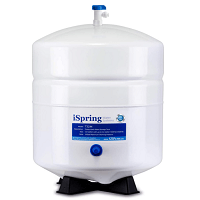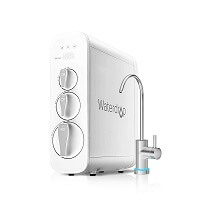The pressurized
tank found in a reverse osmosis system helps store the filtered water. It ensures you get filtered water
on request. However, if the water supply from the tank ever drops, it might be a strong indication of your tank
having an issue.
Does a reverse osmosis tank go bad? Unfortunately, yes, it does because
these tanks are not built to last forever. For example, an air-charged RO storage tank may develop a leak or a
valve seal failure. Likewise, a water-on-water tank may develop control head valve failure. Each situation
necessitates the filter.
Knowing your reverse osmosis system’s water storage tank has gone bad can be
a painful revelation. Fortunately, it is inexpensive and easy to change a reverse osmosis storage tank. You may
even decide to go for a larger and better thank than the one you are replacing.
Read on to learn how to check if your reverse osmosis storage tank has gone
bad and the easy replacement options you can consider;
The Working Principle of a Reverse Osmosis Storage Tank
In the case of a standard air-charged water storage tank, there is a bladder
holding the reverse osmosis water in and in-store until you need it. You can only get water out of the tank when
there is enough air pressure against the outside of the water bladder. The bladder is suspended from the
top, where it feeds water in and out of the tank. The base of the tank contains compressed air, which presses
against the outside of the water tank. This continuous press forces the water out of the reverse osmosis
faucet.See more about What Is A Reverse Osmosis Pressure
Tank?
For water-on-water reverse osmosis water storage tanks, the principle is the
same, except that the pressurized air doesn’t force the water out of the tank. Instead, the household water is
fed into the tank, where it compresses the water bladder. The compression causes reverse osmosis water to move
out of the tank. As basic as the water storage tank in a reverse osmosis system, there is a moving part, the
bladder. The continuous contraction and expansion of the bladder eventually lead to wear and tear.
How do you know that your reverse osmosis tank needs replacing?
You do not have to wait until your reverse osmosis tank stops supplying
filtered water before you make a move to replace it. However, there are certain signs or hints you can look out
for. For instance, if the water supply cuts after a few seconds, your reverse osmosis system is not filtering
enough water or the filtered water is not getting to the tank. It could also be due to the inability of the
water to come out of the tank. In this case, there is a fix – repressurizing your
storage tank.
How do you repressurize your reverse osmosis storage tank?
Start by checking if your tank is full. A full tank is not necessarily 100%
full. Under normal conditions, a part of the tank is reserved for pressurized air. Shaking the tank will tell
you what you need to know. If it feels like there is a lot of water but not full from top to bottom, there is
nothing to worry about.
But if the tank feels like it is completely filled with water, there is a
problem. It may be due to a leaky bladder, with the water from the leak filling up the whole tank. In this case,
replace the tank, but only you have tried repressurizing without success.

Why would the RO tank go bad?
Wear and tear may cause your storage tank to go bad.
Despite the overall sturdy build of reverse osmosis water storage tanks, as well as
the flexibility and durability of the bladders, the system is not immune to wear and tear. For example, there is
a contraction of the bladder every time you collect water from the tank. Likewise, there is an expansion of the
bladder every time the RO system makes filtered water and sends it into the tank.
The rubber bladder is firm, but the continuous contraction and stretching
make it more susceptible to wear and tear, usually in the form of a crack or hole. This does not happen early;
it takes up to a decade or more in some cases. Just prepare your mind that the rubber bladder will wear out and
be due for a replacement after a very long period of continuous use.
Higher risk of wear and tear for bladders in RO tanks laying on their sides.
Suppose you have the water storage tank for your reverse osmosis laying on
its sides due to limited space or convenience. In that case, it is at a higher risk of a bladder tear. While
this position doesn’t hinder the optimal performance of the tank, the water in the bladder forces it to stay on
one side. As a result, that downward-facing side of the bladder becomes more susceptible to wear.
The bladder is also at a higher risk of developing a hole because of the
one-sided force since the other side (upward-facing side) may have much more water and tear than the pressured
side.
The bladder may rub on the inside of the tank.
If you regularly draw a large amount of water from the storage tank of your
RO system, the bladder will contract more and move more frequently. This means the bladder will rub against the
inside walls of the tank. Despite the smooth surface of the inside walls, certain areas of the rubber bladder
will become thin due to continuous rubbing. These areas are more prone to a crack or a hole.
Failure of the seal between the bladder and the tank.
The bladder in the storage tank of a reverse osmosis system is tightly
sealed to the valve. This is necessary to allow the water to flow in and out of the tank easily. But this seal
is prone to failure, malfunctioning, or wear and tear. So while the seal of a storage tank valve hardly fails,
you cannot entirely rule out the possibility. If it happens, you would need to replace the tank.
Chlorine can make the storage tank bladder prone to cracking.
Chlorine finds its way
into your water during the treatment at the municipal plant. If your RO system has a carbon pre-filter, it gets
rid of the chlorine during filtration. However, over time, the filter gets worn out and loses its ability to
filter off the chlorine. This means the chlorine will end up in the storage tank of your reverse osmosis system.
In the tank, the chlorine facilitates the deterioration of the bladder,
making it weak. Over time, the weakness increases and leads to a crack, which means the bladder will not hold
the filtered water.
Low air pressure may lead to the rupturing of the bladder.
The filtered water from your reverse osmosis system goes into the storage
tank. This feeding process continues until the pressure from the storage tank signals to the tank to stop. Low
air pressure in the tank means the feeding will continue, and the bladder will get overfilled and overstretched.
If the pressure stays down for a long time, the bladder continues stretching and becomes more fragile.
The bladder can stretch to about 2x the original size, and ultimately
developing a hole. This is why you should check your reverse osmosis storage tank air pressure regularly. You
can do this with a low-pressure gauge, especially after replacing your reverse osmosis filters.
The normal pressure for most standard tanks is 7-8 pounds per square inch.
Sticky valves are possible in water-charged reverse osmosis storage tanks.
Several reverse osmosis water storage tanks rely on the pressure of your
household water to force the filtered water out when you turn on the faucet. While they are most durable and
long-serving, they are prone to the problem of sticky valves.
Certain valves in these tanks regulate the flow of water in and out of the
tank. Unfortunately, over time, these valves get tired and tend to stick. When this happens, water inflow and
outflow ceases. Sometimes, you can fix this by lubricating the valves. But if this doesn’t work, you may need to
replace the tank with a standard reverse osmosis tank.
How can you get more life out of your reverse osmosis tank?
There is little you can do to increase the lifespan of your reverse osmosis
water storage tank. But you can ensure optimal and consistent performance by allowing the bladder in the tank to
empty completely once in a while. Here are the benefits of doing that;
Your water stays fresh.
The reverse osmosis system filters water periodically to make up for the
water used in the storage tank. This means the old water gets mixed with the newly filtered water. While this is
not a problem, you can get only freshwater by emptying your reverse osmosis storage tank completely, and
allowing the RO to replenish it with fresh water. This means you get fresh filtered water for drinking.
Your water bladder stays limber.
The rubber constricts and flexes when you empty the bladder completely.
Regular contraction and expansion of the bladder keep it healthy and reduce a crack or tear developing.
In Conclusion
You now know more about reverse osmosis water storage tanks, how they work,
and what you can do to keep them performing optimally. Remember, the tank is a crucial part of the reverse
osmosis system and must be kept in the best condition to ensure you get clean and safe water at all times. If
you are not a handy person and doesn’t care much about maintenance, it’s suggested to choose a tankless
RO purifier. Without a storage tank, you never need to worry about water leakage, slow water flow or
contaminants breeding in the tank.





